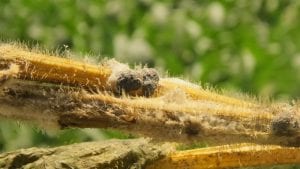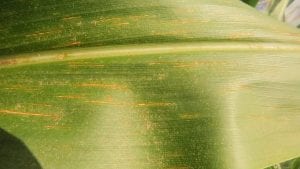Contents
View from the Field
Sudden Death Syndrome and Soybean Cyst Nematode in soybeans
Jaime Cummings, NYS IPM
It has been an optimal year for sudden death syndrome (SDS) in some parts of the state. Reports and diagnoses have been received in western and northern NY fields. This disease is favored by cool, wet spring conditions, followed by hot and dry weather. The infection occurs very early, at germination and emergence, but symptoms rarely appear before reproductive stages and pod filling. Symptoms are most obvious as interveinal chlorosis on the leaves, and can be confused with other diseases that have similar foliar symptoms, including brown stem rot and northern stem canker. Splitting the stems of an SDS infected plant will reveal a white pith with discoloration of the vascular tissue of lower stems (see photo).
Few varieties adapted to our region are available with moderate resistance to this disease, and rotation is not very effective since the pathogen can survive for many years in the soil and on other crop debris. The ILeVO seed treatment has shown good results in trials from other states, and may be your best bet for managing SDS in fields with a history of the disease. Improving drainage and compaction and delaying planting until soils have warmed up, in addition to planting moderately resistant varieties (where available) with seed treatments, are good IPM practices for fields affected by this disease.
It’s also important to note that there is a synergistic effect of SDS and the soybean cyst nematode (SCN). If you have a field with a history of SDS and lower yields, this would be a good candidate for SCN testing. We are approaching the optimal time to take soil samples for SCN testing. There are many public and private labs available for SCN testing. The Cornell plant diagnostic clinic offers this service, and there are a number of labs and clinics that specialize in this service and accept out of state samples. The most highly recommended testing facilities include the University of Missouri SCN Diagnostics lab, the University of Illinois Plant Clinic, and Midwest Laboratories. Please see a complete list of testing labs and other information on SCN provided by the SCN Coalition: https://www.thescncoalition.com/application/files/7915/2581/0504/Public_labs.pdf https://www.thescncoalition.com/application/files/1015/2581/0504/Private_labs.pdf https://www.thescncoalition.com/
Sudden Death Syndrome (photo by Jaime Cummings)
White Mold (Sclerotinia stem rot) in soybeans
There have been increasing reports of white mold in soybeans in NYS. I saw a lot of it in Eastern NY (mid-Hudson Valley) because some fields are planted back to back years with soybeans. Soybeans should be rotated every year. In fields with a history of infection, rotating out of soybeans for several years will help reduce the pathogen.
Corn earworm (Helicoverpa zea) in field corn
I rarely find corn earworm in field corn. This week I was in a field that had a fair amount of damage by corn earworm. While I do not think the earworms were causing economic loses to silage corn, it was more than I had seen in a field before. While looking for western bean cutworm you might come across this pest also. The difference is that corn earworms will only allow one earworm per ear. They are cannibalistic and do not like to share. You can have several western bean cutworm larvae per ear. They seem to like to have a party on your ears of corn.
Northern corn leaf spot (Bipolaris zeicola) in field corn
Scouting corn this week I was in a field with a fair amount of northern corn leaf spot, and there have been widespread reports of this disease in other areas. The infected leaves spread up to the ears. I do not think this is going to cause yield loses because the corn is close to harvest.
Soybean aphids (Aphis glycines) on soybeans
I was in a soybean field where the soybean aphids were near threshold (average of 250/plant) but the beans were at the R4 to R5 stage of growth. Once past the R5 stage aphids do not cause much damage to soybeans. There were also a lot of lady beetles in the field. Lady beetles and other natural enemies help keep populations under threshold much of the time.
Weather Outlook – August 30, 2018
Jessica Spaccio
NOAA Northeast Regional Climate Center, Cornell University
Last week temperatures were 2 to 6+ degrees above-normal. Precipitation has ranged from a trace to over 1”. Base 50 growing degree-days ranged from 80-160.
Cooler temperatures to finish the week! Scattered showers possible over the holiday weekend with hot and humid temperatures returning next week.
Today temperatures will be much cooler for most areas, in the upper 60s to lower 80s with lower humidity. Eastern NY will still be warm and humid for part of the day until the cold front exits. Some showers and thunderstorms, associated with the front, will be possible. Overnight lows will be in the 50s to near 60, some upper 40s.
Friday will be in the 70s with scattered afternoon showers and thunderstorms. Overnight temperatures will be in the 50s to 60s.
Saturday temperatures will be in the mid 60s to low 80s, with a chance for afternoon/evening showers and thunderstorms. Overnight temperatures will be in the upper 50s to 60s.
Sunday highs will be in the mid 70s to mid 80s with a chance for afternoon/evening showers and thunderstorms. Overnight temperatures will be in the upper 50s and 60s.
Monday temperatures will be in the 80s with a chance for afternoon/evening showers and thunderstorms. Overnight temperatures will be in the 60s.
Tuesday highs will be in the 80s to low 90s with a chance for afternoon/evening showers and thunderstorms. Overnight temperatures will be in the 60s.
Wednesday highs will be in the 80s to low 90s with continued muggy conditions and a chance of showers. Overnight temperatures will be in the 60s.
The seven-day precipitation amounts will range from a quarter inch to one and a half inches.
The 8-14 day outlook (Sept 5 – 11) favors above-normal temperatures and above-normal precipitation for the the state.
Maps of 8-14 day outlooks:
http://www.cpc.ncep.noaa.gov/products/predictions/814day/index.php
National Weather Service watch/warnings map:
US Drought Monitor:
http://droughtmonitor.unl.edu/Home.aspx
CLIMOD2 (NRCC data interface):
http://climodtest.nrcc.cornell.edu
Western Bean Cutworm Update 8.31.18
Clipboard Checklist
Keith Waldron, NYS IPM
General
*Walk fields to check general field condition, weed, vertebrate and other issues
*Watch for crop maturity, stand assessments, weed escapes, nutrient deficiencies, lodging issues
*Update crop records and field history
Alfalfa:
*Evaluate established legume stands for approximate days until harvest
*Monitor potato leafhopper, foliar, systemic and crown rot diseases.
*Monitor new seedings for potato leafhopper, pythium blight, phytopthora root rot.
Small Grains:
*Monitor grain fields for growth stage, disease and lodging issues, grain maturity, harvest timing
*Record diseases present, location and types of weed escapes
* Prepare for planting winter small grains after the Hessian Fly Free Date.
Corn:
*Monitor for mid-season corn pests including European corn borer, corn rootworm, western bean cutworm, slugs, foliar diseases such as northern corn leaf blight and gray leaf spot, weed issues, nutrient deficiencies, vertebrate damage.
Soybeans:
*Monitor for growth stage, soybean aphid, defoliators, foliar diseases, white mold, weed issues, vertebrate damage
Pastures:
*Check water sources, mend fences as needed.
*Check crop growth, clip pastures between grazing as needed
*Monitor for invasive species, plants harmful to livestock
*Review/Plan rotations
Storage:
* Check stored grain bins for temperature, moisture and signs of mold and insects. Aerate, core, transfer grain or treat as necessary
* Clean and disinfect empty storage bins in preparation for grain harvest
*Check forage allocation and anticipate feed program adjustments as forages from previous year are used up
*Mow around storage bins and facility to minimize pest hiding places
Dairy Cattle Barn Fly Management:
*Monitor animals and barn area for house fly, stable fly and other pest management needs including presence of rodents and birds.
*Check facilities for favorable fly breeding conditions: (organic matter + moisture): leaks in watering systems, roof gutters for leaks and potential overspill, drainage,
*Sanitation, sanitation, sanitation – clean animal resting areas, feed troughs, minimize source of moist organic matter i.e. fly breeding areas in barn and in adjacent animal loafing yard
* Continue fly monitoring: install “3X5″ index card fly speck monitoring cards throughout barn
*Use, replenish, replace fly management materials: sticky fly tapes/ribbons, insecticide baits, natural enemies (parasitoids), fly population monitoring (3 x 5) spot cards
*Consider purchase and release of Muscidifurax raptor and/or M. raptorellus natural enemies of house and stable fly pupae.
Dairy Cattle on Pasture:
*Monitor animals for presence of face flies, horn flies and stable flies. Action guidelines: face flies (average 10 per animal face), horn flies (average 50 / dairy per animal side, 200 / beef cattle per animal side), stable flies average 10 per animal (all four legs)
*Check feed bunk / water source locations for signs of stable fly breeding (moist undisturbed organic matter – spilled feed, round bales, etc.), minimize source of moist organic matter i.e. fly breeding areas in barn and in adjacent animal exercise yard.
*Check pasture for forage quality / quantity, rotate as appropriate
*Check pasture for vegetation poisonous to livestock
*Consider use of pasture fly traps to help reduce deer, horse and stable fly populations







